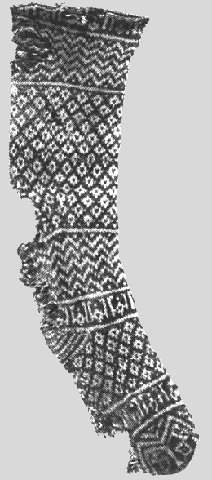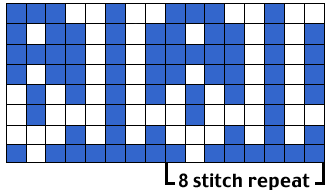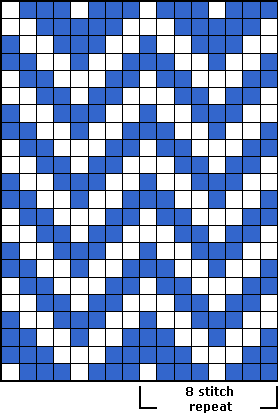Dar Urtatim: Medieval Egyptian Knitting 2My Recreation ofA Medieval Egyptian Sockin |
|
I have very little actual information on this sock. It was found somewhere in northern Egypt, and dates from sometime between the 11th and 14th centuries CE. It is made of both natural and dark indigo blue cotton. It was knit in the round in stranded knitting. I don't have the gauge. My sock came just below my knee. Since it was my first stranded knitting, first sock, and third knitted project ever, I didn't use cotton, as experienced knitters have said it is more difficult than wool to work with. I have used it on historical recreation projects after I had a bit more experience Also, my toe reconstructs the one on a different Medieval Egyptian sock in the Textile Museum, rather than the sock pictured, as it was difficult to make out the tip of the toe in this photo. And finally, this was the first time I ever tried to write out knitting directions, so I can't guarantee that they are flawless. My e-mail address is on the bottom of the page. If I've made some egregious errors, please let me know so I can correct them. Needles I UsedI used 5 double pointed needles, size 2 US, 2.75 MM. I find it easiest to use a set of 5 double pointed needles, rather than 4, and I suggest you give it a try. It makes much more sense to me to knit a tube as a square on 4 needles with a 5th working needle, than to knit a tube as a triangle on 3 needles with a 4th working needle. You could also use a circular needle of the right size. Yarn I Used
WHITE:
BLUE: The actual historic socks were of cotton. You could try that if you're a more experienced knitter than I was.
MY GAUGE: |
 
Starting the Sock
Chart Legend |
Large Diamond Toe ChartTo use this chart: start at the top and work down, and start on the right and work to the left.
Small sock - 4 diamonds on the toe:
Medium sock - 5 diamonds on the toe:
In every case:
20: Knit all blue. |
Allah ChartTo use this chart: start at the bottom and work up, and start on the right and work to the left.
Start at the right edge of the chart, knit one blue, etc. and follow the chart for a total of 8 rounds. 33: Knit all blue. |
Diapered Diamonds ChartTo use this chart: start at the bottom and work up, and start on the right and work to the left.
Repeat the pattern as many times as necessary to fit foot. Mine has approximately 2-1/2 repeats, ending on row 5. The original has 3 repeats. Knit one round all blue. |
HeelThe heel is formed as a "short row heel", which involves knitting back and forth. You will be knitting on only 2 needles, leaving 2 at rest until the heel is complete.
Knit two rounds all white. |
Allah chartWork entire chart
Knit one round all blue. |
Zig-Zag ChartTo use this chart: start at the bottom and work up, and start on the right and work to the left.
Work entire chart
Knit one round all blue. |
Remainder of LegFirst, measure the length of the Allah band and Zig-Zag band including the white and blue band between the them. Repeat Diapered Diamonds pattern as many times as necessary to fit length of leg, minus the length of Allah and Zig-Zag bands. Mine has approximately 3 repeats. The original has 6-1/2 repeats. Make sure to keep knitting loose enough - after all, it has to stretch over your calves.
Knit one round all blue. Repeat Zig-Zag chart
Knit one round all blue. Repeat Allah chart Knit one round all blue. |
Finishing the SockHow the original sock was actually finished is unclear to me. Before casting off, you may want to knit another row of blue and cast off with blue. Or you may prefer, as I do, to knit a row of white and cast off with white. I would say that it is important to cast off in such as way that the top edge isn't unelastic, as it has to stretch over your calf. But it shouldn't be too loose and baggy. After I cast off, I used the working yarn to make a long chain stitch tie that could wrap around my leg and be tied, to help keep the sock up, as can be seen on a number of modern ethnic Near Eastern and Central Asian socks. I finished the chain with a small tassel of the same yarn. The other option is to secure the sock with a separate band of some sort as a garter. |
|
Return to the Knitting Room in Dar Urtatim. Return to al-Riyad, the Courtyard at Dar Urtatim Questions? Comments? Suggestions?
You can write to me here. |



